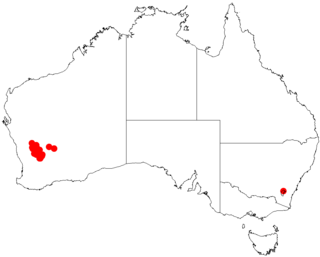
Acacia ancistrocarpa, commonly known as fitzroy wattle, is a shrub belonging to the genus Acacia and the subgenus Juliflorae. The shrub is also known as fish hook wattle, pindan wattle and shiny leaved wattle.

Acacia desertorum is a shrub belonging to the genus Acacia and the subgenus Juliflorae that is endemic to western Australia.
Acacia incongesta, also known as Peak Charles wattle, is a shrub belonging to the genus Acacia and the subgenus Juliflorae that is endemic to a small area in south western Australia

Acacia jibberdingensis, also known as Jibberding wattle or willow-leafed wattle, is a shrub or tree belonging to the genus Acacia and the subgenus Juliflorae that is endemic to Western Australia.

Acacia levata is a shrub belonging to the genus Acacia and the subgenus Juliflorae that is endemic to small arid area of western Australia.

Acacia multispicata, commonly known as spiked wattle, is a shrub belonging to the genus Acacia and the subgenus Juliflorae that is endemic to south western Australia.

Acacia dempsteri is a shrub belonging to the genus Acacia and the subgenus Phyllodineae endemic to south western Australia.

Acacia excentrica is a shrub belonging to the genus Acacia and the subgenus Phyllodineae native to Western Australia.

Acacia merrickiae is a shrub belonging to the genus Acacia and the subgenus Phyllodineae that is endemic to a small area of south western Australia.

Acacia pulviniformis is a shrub of the genus Acacia and the subgenus Phyllodineae that is endemic to south western Australia.

Acacia validinervia also commonly known as nyalanyalara, nyala nyala, alumaru or blue wattle, is a shrub of the genus Acacia and the subgenus Phyllodineae endemic to arid areas of inland Australia.

Acacia ascendens is a shrub of the genus Acacia and the subgenus Plurinerves that is endemic to a small area in south western Australia.

Acacia chrysopoda is a shrub of the genus Acacia and the subgenus Plurinerves that is endemic to an area of south western Australia.

Acacia obtecta is a shrub of the genus Acacia and the subgenus Plurinerves that is endemic to a small area in south western Australia.

Acacia gillii, commonly known as Gill's wattle, is a shrub belonging to the genus Acacia and the subgenus Phyllodineae that is native to parts of southern Australia.

Acacia semirigida, also known as stony ridge wattle, is a shrub or tree belonging to the genus Acacia and the subgenus Phyllodineae native to north eastern Australia.

Acacia torringtonensis is a shrub belonging to the genus Acacia and the subgenus Phyllodineae native to eastern Australia.

Acacia kybeanensis, commonly known as kybean wattle or kybeyan wattle, is a shrub of the genus Acacia and the subgenus Phyllodineae that is endemic to south eastern Australia.

Acacia linearifolia, commonly known as stringybark wattle or narrow-leaved wattle, is a shrub or tree of the genus Acacia and the subgenus Phyllodineae that is endemic to eastern Australia.

Acacia tarculensis, commonly known as granite wattle, granite bush or steel bush is a shrub belonging to the genus Acacia and the subgenus Juliflorae that is native to south central Australia.





















